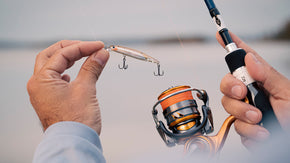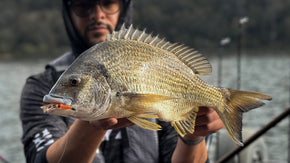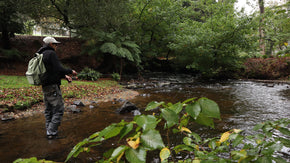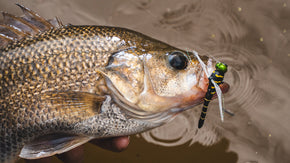Posted 30th October 2025
The Private Life of Cod


By Joshua Bland, BSc Marine Biology
The luminous white eggs popped against the tannin backdrop, laid across the mud like a thin veil of crumbled Styrofoam. After months of waiting, I finally had my answer…
Rumoured to reach 1.8m long and weighing over 100kg, these river-dwelling behemoths are the inspiration for gods of First Nations’ dreamtime, capturing the admiration of both anglers and the public alike. Murray cod have developed a cult-like following among anglers as a highly respected sport fish that requires a lifelong pursuit to master. But behind this apex predator lies a fascinating life history that, until the late 20th century, was a complete mystery to modern science. In this blog, we dive deeper into the science behind the private life of cod and the life cycle that sustains this living legend, generation to generation.

That’s amore
Understanding the baby-making of fish takes a little more than peeking through their bedroom window. Particularly when the window in question is like peering into a bucket of chocolate milk. The sediment-filled water of freshwater rivers makes seeing and understanding their behaviour in the wild incredibly challenging. Despite this, researchers have been studying cod reproduction for decades, with some of the first publications coming out as early as the 1960s. Researching how cod spawn became popular off the back of a pretty brutal commercial industry in the Murray-Darling Basin that witnessed a crash of roughly 85% in the annual catch between 1950 and 1965. Now, 60 years later, we have a much clearer picture of what is happening beneath the surface.
Murray cod, like most species of freshwater fish, spawn in early spring. The warmer water and plethora of food create ideal conditions for raising kids. This time of year provides young with the highest chances of survival. Mature females (~3 years old) lay roughly 11,000 spherical, pearlescent eggs, about 3mm in diameter – large by fish standards. However, fish over a metre can lay over 86,000! For some time, it was widely believed that cod need strong river flows or floods to spawn. Whilst this appears to be true for the Murray River’s second most beloved sportfish, golden perch, many studies now seem to agree that it is not a requirement for successful spawning. Cod successfully spawn in aquaculture tanks, ponds, and dams where little to no flow is available. The additional flow and the associated increase in food may benefit the survival of the larvae, but what we find is that there are more important factors at play.
A study published by Butler and others (2022) found that rising temperature, longer day length and moon phase (new moon) all appear to play a part in deciding the big hurrah. However, fish spawning is complex, sometimes changing year-to-year and especially as the climate changes. In general, spawning falls between August and November at lower latitudes (Queensland and NSW) and between September and January at higher latitudes (Victoria and South Australia). For example, an underwater livestream project (codpods) I facilitated at RecFish SA in 2024 recorded spawning in mid-October in stocked reservoirs – about three months later than the earliest observed spawning in Queensland and New South Wales.

A not-so-nuclear family
Murray cod have vastly different parenting views compared to most fish. Cod are nesters and take an active role in both preparing and caring for the eggs. This strategy is unlike many other predatory fish in the basin, which release their sperm and eggs in a reckless orgy followed by child abandonment, otherwise known as broadcast spawning. All fun, no responsibility might sound great, but relying on quantity over quality often lowers the likelihood of survival. Murray cod, on the other hand, lay their eggs in caves, hollows, under logs, or depressions where they can protect them for their entire development.
Male cod make for the perfect househusband and are responsible for locating and preparing a suitable nesting site. They then meticulously fan, tidy, and defend their chosen nest to make sure it is in the best condition for prospective lady friends. Much like humans, girls like a man who cleans up after himself and she will inspect the site to work out if he’s up for the task of fatherhood. During the spawning season, some males will compete for the best spots. Those who can hold onto the best spots likely show the females that their genes are the fittest and will give her children the best chance of living to reproductive age.
After she lays her eggs, the female abandons the site, leaving the male to care for the eggs for 1-2 weeks. During this time, instead of hunting, he will constantly fan the eggs to ensure they get adequate oxygen. He will become highly aggressive, defending the nest from predators and other males. After roughly 1-2 weeks, the eggs will hatch, after which the male continues to care for them until the larvae are strong enough to take off and start the cycle all over again.
A green future
Cod in their native range are still recovering from a brutal history of overfishing, habitat destruction, and fundamental changes to the rivers in which they inhabit – scars of which are still felt today. Despite this, they are a remarkably resilient species. Extensive conservation and regulatory efforts have helped cod begin to claw their way back. Closed seasons were designed with their reproductive biology in mind to give them the best chance to not only survive but to thrive.
Cod fishing closures in NSW (September – November), QLD (August – October), Victoria (September – November), and in SA (August – December) allow breeding pairs to conduct their activities stress-free while accounting for variation across locations during the important months. A study by Rowland (1988) found that handling cod during the breeding season causes resorption of their sperm or eggs, thus effectively cancelling a potential spawn for that fish that year. This is why it is important to follow closures and target other species. The best thing we can do for their future, and the future of cod fishing, is to respect the closures and promote our strong culture of caring for these animals. That way, we can protect this Australian icon for generations to come.
















